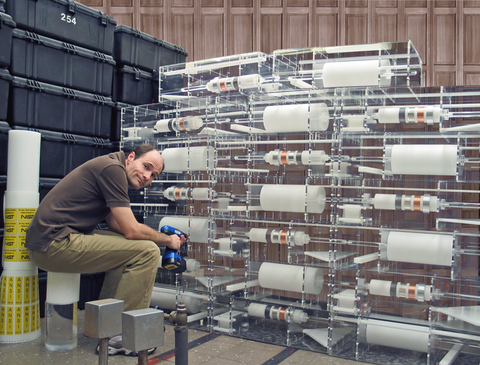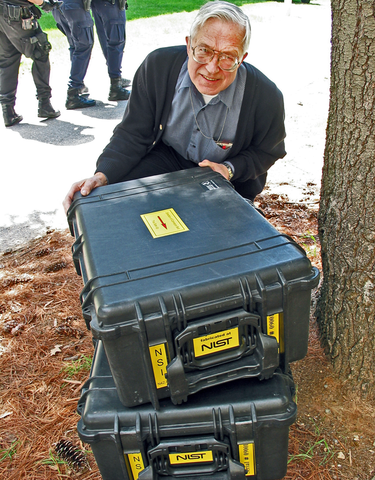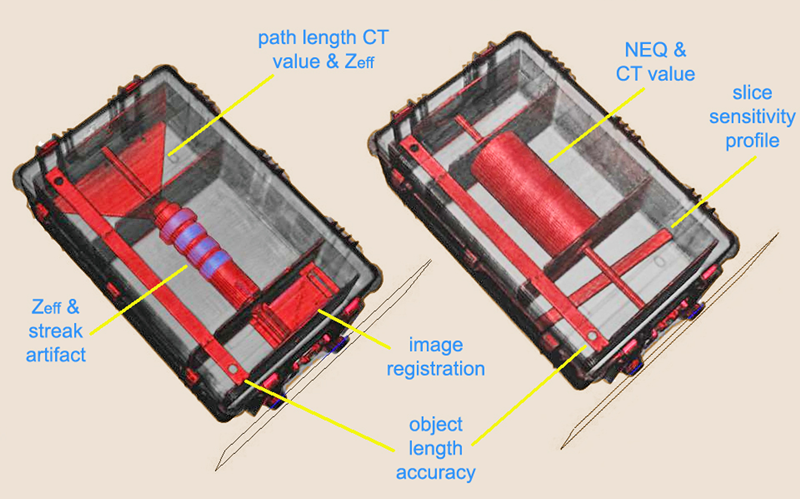
Larry Hudson with NIST-fabricated examples of test artifacts called out by the new CT image quality standard for security applications.
Every month, between 50 and 70 million passengers travel through U.S. airports, toting more than 30 million pieces of luggage destined for aircraft cargo holds. Since 2004, federal legislation requires that every one of those checked bags – around a million a day – has to be scanned for explosives and other threats, typically using computed tomography (CT) machines similar in operation to those used in medical diagnostics but several times as long.
Until recently, however, there was no national standard for evaluating the imaging quality of CT machines used for security screening, about 2,000 of which are deployed at 450 major U.S. airports. That represents an annual investment of many billions of dollars. Several years ago, the Department of Homeland Security's Office Standards tasked NIST with developing consensus standards for these machines.
The intent of this standard is to avoid inconsistencies in the manner in which image quality is measured, to ensure that limited resources are well spent, to provide users with a methodology for conducting factory and site acceptance tests, and to monitor the performance of deployed systems over time.
"It's been our job to bring all the stakeholders together – the government people who test and certify equipment, and all the vendors who make CT security-screening systems – and then work out what is important to measure and how best to measure it," says physicist Larry Hudson of the Dosimetry Group in PML's Radiation and Biomolecular Physics Division.
By 2011, Hudson and colleagues had devised and refined a set of testing procedures, and had developed and fabricated dozens of sets of two suitcase-sized test articles, each containing multiple test objects. In May 2011, the combination was issued as the American National Standard for Evaluating Image Quality of X-ray Computed Tomography (CT) Security-Screening Systems (IEEE ANSI N42.45).
"This standard test method defines test objects and image-analysis algorithms for a range of image quality indicators relevant to CT security screening," Hudson says. "It's probably one of the most mathematically intensive standards our project has produced."*

Twenty-four months later, it is now unequivocally clear that the effort is a major success. A key partner has been the Department of Homeland Security's Transportation Security Laboratory (TSL), which is responsible for testing and certification of Explosive Detection Systems including the CT machines used for checked luggage.
A few weeks ago, William Petracci, Test Director of TSL, announced that the standard "has enabled the Certification Program to significantly reduce the number and duration of laboratory compliance tests involving live explosives. This has enabled us to maintain pace with technology refreshment of deployed Explosives Detection Systems and provide time critical support to TSA (Transportation Security Administration). The result has been significant savings in cost, labor, and reduced risk to personnel."
Moreover, Hudson says, "people around the world are asking us for copies of these test objects. The first two roomfuls were fabricated at NIST, and TSL recently hired a contractor to make more. Now we are trying to take it international. There is no international image quality standard for CT security systems at present."
Later this month, Hudson will travel to Moscow where he hopes to establish a new working group on CT security-screening systems within the International Electrotechnical Commission, the world's leading organization for the preparation and publication of international standards for electrical, electronic, and related technologies.
An eventual international standard could have a major impact on baggage screening for the estimated 50,000 commercial flights per day worldwide – or at least on technical equipment performance. "It should be an easy argument to win: International security standards affect our homeland security," Hudson says. "We are also pushing for the adoption of a standard image format for CT that will improve security and throughput."
The U.S. CT standard applies to image quality, not to the methods a system uses to interpret those images and determine whether they reveal something benign (such as a wedge of cheese) or a threat (such as a wedge of plastic explosive).
By having uniform test objects and performance criteria, manufacturers can better improve their explosive detection algorithms. That automation software is the first line of defense in the checked-luggage screening process, and it is important not only for public safety, but also for maintaining the high-volume screening that busy airports require to keep things moving on time.
At U.S. airports, human beings do not get directly involved in screening until the scanner algorithm flags a suspicious item. At that point, the image is handed off to an agent for evaluation. If the image is still suspicious or unresolved, then the process proceeds to level three, in which officers open the luggage and examine the contents.
"Ideally, that should happen as infrequently as the system will permit, consistent with safety," Hudson says. "It is very expensive in time and money to open a bag. In addition to detecting threats, avoiding false positives is another reason why image quality is such an essential part of the screening process."

* This project also facilitates the development of technical performance and radiation safety standards for all venues that employ x-ray or gamma ray security screening systems. In addition to CT, these include checkpoint x-ray cabinet systems for carry-on bags, cargo/vehicle imaging and interrogation systems, whole body imaging, and the portable x-ray sources used by bomb squads.

